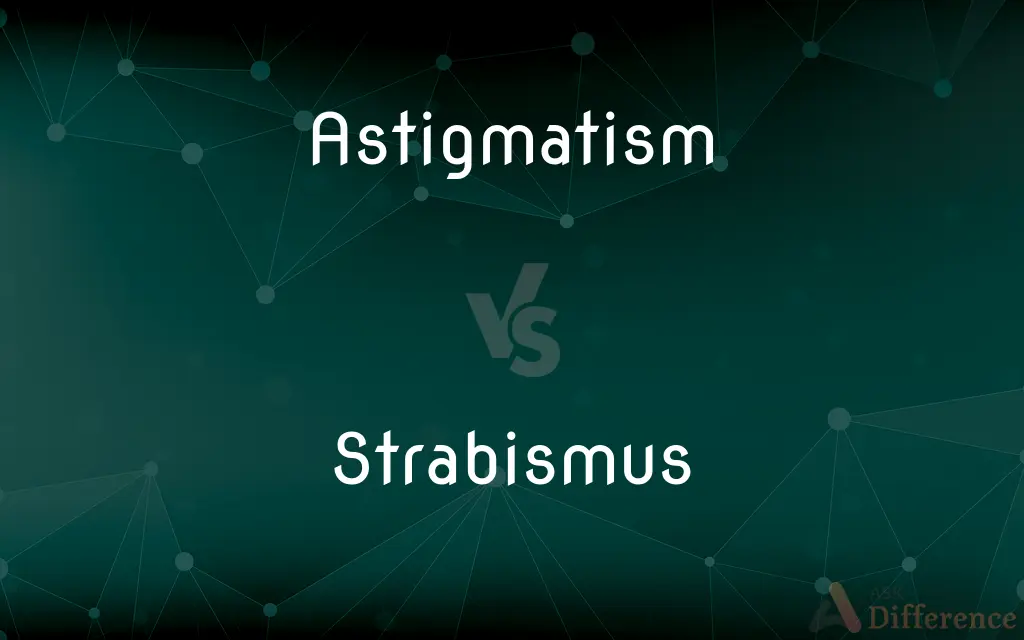Astigmatism vs. Strabismus — What's the Difference?
By Maham Liaqat & Fiza Rafique — Updated on March 1, 2024
Astigmatism is a refractive error causing blurred vision due to an irregularly shaped cornea, while strabismus is a condition where the eyes do not properly align when looking at an object.

Difference Between Astigmatism and Strabismus
Table of Contents
ADVERTISEMENT
Key Differences
Astigmatism results from an irregular curvature of the cornea or lens, leading to distorted or blurred vision at all distances. It's a common vision condition that can occur alongside nearsightedness or farsightedness. Strabismus, on the other hand, involves a misalignment of the eyes, such as one eye turning in, out, up, or down, independent of the other eye's focus.
Individuals with astigmatism may experience headaches, eye strain, or discomfort after visual tasks, due to the effort required to focus on blurred images. Those with strabismus might experience double vision, as the misalignment prevents both eyes from focusing on the same point simultaneously, causing confusion to the brain.
Astigmatism is primarily corrected through glasses, contact lenses, or refractive surgery, which aim to compensate for the uneven curvature of the cornea or lens. Treatment for strabismus may include eyeglasses, eye exercises, prism lenses, or surgery to adjust the muscles around the eyes to achieve proper alignment.
The causes of astigmatism relate to genetic factors or certain types of eye surgery, indicating a structural defect in the eye. Strabismus can also be congenital or develop due to neurological disorders, muscle control issues, or other health problems, suggesting a broader range of potential causes.
Astigmatism and strabismus both impact vision, but in different ways. While astigmatism affects the clarity of vision due to the shape of the eye, strabismus affects the alignment and coordinated movement of the eyes, leading to potential issues with depth perception and binocular vision.
ADVERTISEMENT
Comparison Chart
Definition
A refractive error caused by an irregularly shaped cornea or lens.
A condition where the eyes do not align properly when focusing on an object.
Main Symptom
Blurred or distorted vision at any distance.
Misalignment of one or both eyes in different directions.
Common Treatments
Prescription glasses, contact lenses, refractive surgery.
Glasses, eye exercises, prism lenses, surgery.
Causes
Genetic factors, corneal shape, eye surgery.
Congenital factors, neurological disorders, muscle control issues.
Impact on Vision
Affects clarity and sharpness of vision.
Affects eye coordination, depth perception, and can cause double vision.
Compare with Definitions
Astigmatism
A vision condition causing blurred vision due to an uneven cornea.
She wears special contact lenses to correct her astigmatism.
Strabismus
Eye condition where eyes do not align correctly.
Strabismus surgery helped her eyes to finally look in the same direction.
Astigmatism
Not related to eye alignment but to the shape of the eye.
Astigmatism is due to his eye's oval shape, not how they align.
Strabismus
Treatment may involve surgery to correct muscle alignment.
After strabismus surgery, he no longer needed to tilt his head to see clearly.
Astigmatism
Distorted vision at all distances.
Astigmatism made it hard for him to see both the chalkboard and his book clearly.
Strabismus
Can lead to double vision or depth perception issues.
Because of his strabismus, he saw everything double until he wore his prism glasses.
Astigmatism
(optics) A defect of a lens such that light rays coming from a point do not meet at a focal point so that the image is blurred.
Strabismus
Eye exercises can help strengthen muscles for better alignment.
She does daily eye exercises to manage her strabismus.
Astigmatism
Often accompanied by headaches due to eye strain.
Her astigmatism often caused headaches after reading.
Strabismus
Often diagnosed in childhood but can occur at any age.
Despite that, he was recently diagnosed with strabismus.
Astigmatism
Can be corrected with cylindrical lens prescriptions.
Glasses for astigmatism contain lenses that correct the uneven curvature.
Strabismus
Strabismus is a condition in which the eyes do not properly align with each other when looking at an object. The eye that is focused on an object can alternate.
Astigmatism
Astigmatism is a type of refractive error in which the eye does not focus light evenly on the retina, due to a variation in the optical power of the eye for light coming from different directions. This results in distorted or blurred vision at any distance.
Strabismus
A visual defect in which one eye cannot focus with the other on an object because of imbalance of the eye muscles. Also called squint.
Astigmatism
A visual defect in which the unequal curvature of one or more refractive surfaces of the eye, usually the cornea, prevents light rays from focusing clearly at one point on the retina, resulting in blurred vision.
Strabismus
A defect of vision in which one eye cannot focus with the other on an object because of imbalance of the eye muscles; a squint.
Astigmatism
(pathology) A disorder of the vision, usually due to a misshapen cornea, such that light does not focus correctly on the retina causing a blurred image.
Strabismus
An affection of one or both eyes, in which the optic axes can not be directed to the same object, - a defect due either to undue contraction or to undue relaxation of one or more of the muscles which move the eyeball; squinting; cross-eye.
Astigmatism
A defect of the eye or of a lens, in consequence of which the rays derived from one point are not brought to a single focal point, thus causing imperfect images or indistinctness of vision.
Strabismus
Abnormal alignment of one or both eyes
Astigmatism
(ophthalmology) impaired eyesight resulting usually from irregular conformation of the cornea
Astigmatism
(optics) defect in an optical system in which light rays from a single point fail to converge in a single focal point
Common Curiosities
What causes astigmatism?
It's often hereditary or can result from the cornea's shape, eye surgery, or injuries.
What is astigmatism?
A common vision condition causing blurred or distorted vision due to an irregular curvature of the cornea or lens.
What is strabismus?
A condition where the eyes do not properly align with each other when looking at an object.
How is strabismus treated?
Treatment options include eyeglasses, prism lenses, eye exercises, or surgery to align the eye muscles.
Is astigmatism more common than strabismus?
Astigmatism is more common as a basic refractive error, while strabismus is less common but significant.
Can you have both astigmatism and strabismus?
Yes, it's possible to have both conditions, requiring a combination of treatments.
Can astigmatism be cured?
It can be effectively corrected with glasses, contacts, or surgery but not "cured" in the traditional sense.
What causes strabismus?
It can be due to muscle control issues, neurological disorders, congenital conditions, or trauma.
Does astigmatism affect depth perception?
Not directly, but severe uncorrected astigmatism can impair overall vision quality, which may indirectly affect depth perception.
Can strabismus lead to other problems?
Yes, if untreated, it can lead to amblyopia (lazy eye), where the vision in one eye does not develop properly.
Is strabismus always visible?
Not always; some forms of strabismus are very subtle and may not be noticeable without specific tests.
How does astigmatism affect daily life?
It can cause blurred vision, difficulty driving at night, eye strain, and headaches, impacting daily activities.
Can strabismus worsen over time?
Without treatment, strabismus may not necessarily worsen, but its effects on vision and quality of life can intensify.
Are there exercises to correct astigmatism?
While exercises can't correct the corneal shape causing astigmatism, they can help alleviate eye strain.
Share Your Discovery

Previous Comparison
Tyle vs. Tile
Next Comparison
Gutter vs. RhoneAuthor Spotlight
Written by
Maham LiaqatCo-written by
Fiza RafiqueFiza Rafique is a skilled content writer at AskDifference.com, where she meticulously refines and enhances written pieces. Drawing from her vast editorial expertise, Fiza ensures clarity, accuracy, and precision in every article. Passionate about language, she continually seeks to elevate the quality of content for readers worldwide.














































